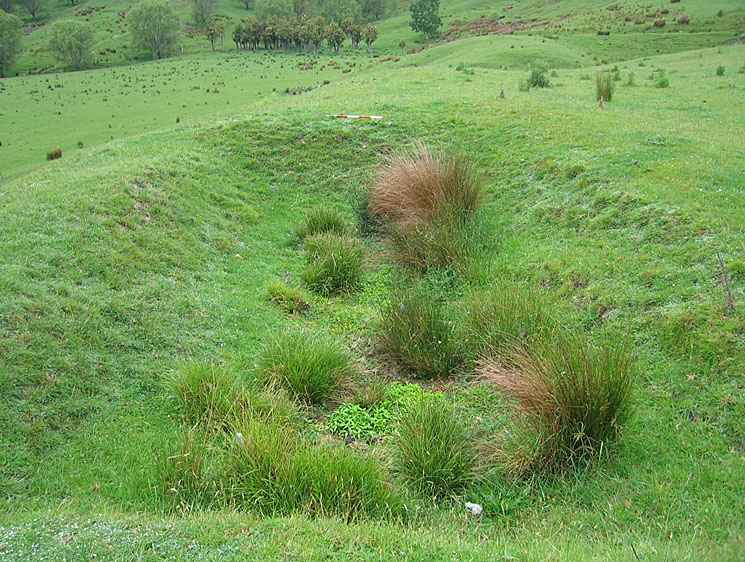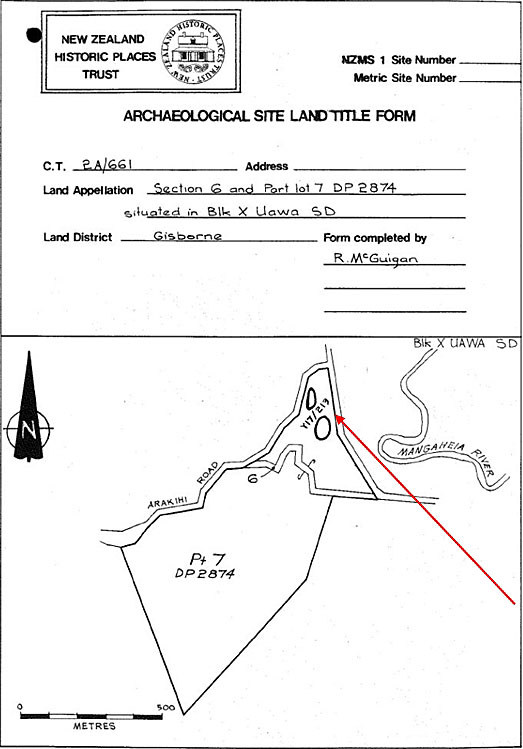New Zealand Archaeological Association Site Record Number Y17/213 is a pit/terrace site that forms part of the dense archaeological landscape of the Tolaga Bay (Uawa) area. It is located on Mangaheia Station, to the west of the Tolaga Bay township. Pit sites and the many other recorded archaeological sites including pa, midden, gardens and urupa reflect the intensive Maori occupation of the Tolaga Bay from the time of initial Polynesian settlement approximately 700 years ago. Access to abundant food resources from the sea, rivers, inland forests and horticultural production (kumara) meant that a large population could be sustained. It has been estimated that the early Maori population of Tolaga Bay totalled approximately 1200; and the main iwi was Te Aitanga a Hauiti. Pit and pit/ terrace sites are very common in Tolaga Bay, and demonstrate the importance of horticulture to Tolaga Bay's earliest inhabitants. The Bay's fertile soils and temperate climate were well suited to kumara gardening, and the pits were used for storing harvested kumara over the winter months. Rectangular storage pits (which were once roofed with a layer of earth), are more prevalent than the underground storage pits found elsewhere in New Zealand, a pattern attributed to the harder substrate of the soil in this area. They are in fact the most common archaeological site type in Tolaga Bay, and are found along the river banks and on the rolling hills to the south of the Bay. They are generally located in clusters on knolls or terraces, or on ridge crests, in lines from end to end, or as is the case with this site Y17/213. Terraces are discrete areas that were deliberately levelled by Maori to create a flat surface for activities or buildings. Pit/ terrace site Y17/213 is located under pasture on a north-south running ridgeline, just south of the intersection of Aratahi and Tauwhareparae Roads. It comprises three distinct groups of pits/terraces. A number of other archaeological sites such are located in the surrounding area, such as the pa, pit and pit/terrace sites to the southwest and north of Tauwhareparae Road and the Mangaheia River. This site was first recorded as part of the archaeological survey work undertaken by archaeologist Kevin Jones in the Whangara, Tolaga Bay and Uawa Catchment areas in 1982-1983. This survey work was undertaken to gain information about the nature of prehistoric settlement in this locality, and also to evaluate specific sites for registration under the Historic Places Act 1980. Jones recorded three separate groups of pits/terraces, which he labelled 'Areas A - C', heading south along the ridgeline. Three pits were recorded in Area A, including a very large pit measuring 8 metres x 4 metres x 1.5 metres (depth). Area B comprised four pits, one pit-like depression and a large terrace measuring 8 metres x 8 metres. As in Area A, the pits were large in size, including another very substantial pit measuring 8 metres x 4 metres x 2 metres (depth). Jones recorded Area C on the basis of an aerial photograph, and asserted that it would have comprised two or more pits stating that no evidence remained on the ground as the area had been disced (a farming technique used to till soils). Pit/terrace site Y17/213 was revisited by the New Zealand Historic Places Trust in November 2007 and whilst Areas A and B were found to be as originally illustrated, a large oval pit on an east-west alignment and some vague put-like depressions were recorded in the approximate location of Jones' 'Area C'. Archaeologist Vanessa Tanner had also previously stated in 2000 that 'Area C' was still visible after examination of an aerial photograph run held by the Gisborne District Council. Y17/213 is one of numerous pit and pit/terrace sites recorded in the Tolaga Bay area, and is particularly notable for the substantial size of its pits and the large terrace feature. It is part of a dense archaeological and cultural landscape that is of considerable significance to Te Aitanga a Hauiti, reflecting the intensive Maori occupation and settlement of the Tolaga Bay area since the 14th - 15th centuries AD, and the important role that horticulture played in this.



Location
List Entry Information
Overview
Detailed List Entry
Status
Listed
List Entry Status
Historic Place Category 2
Access
Private/No Public Access
List Number
6550
Date Entered
9th September 1986
Date of Effect
9th September 1986
City/District Council
Gisborne District
Region
Gisborne Region
Extent of List Entry
The registration includes part of the land described as Lot 7 DP 2874, Gisborne Land District and the archaeological site Y17/213 (New Zealand Archaeological Association Site Record Number).
Legal description
Lot 7 DP 2874, Gisborne Land District
Related listings
Stay up to date with Heritage this month
